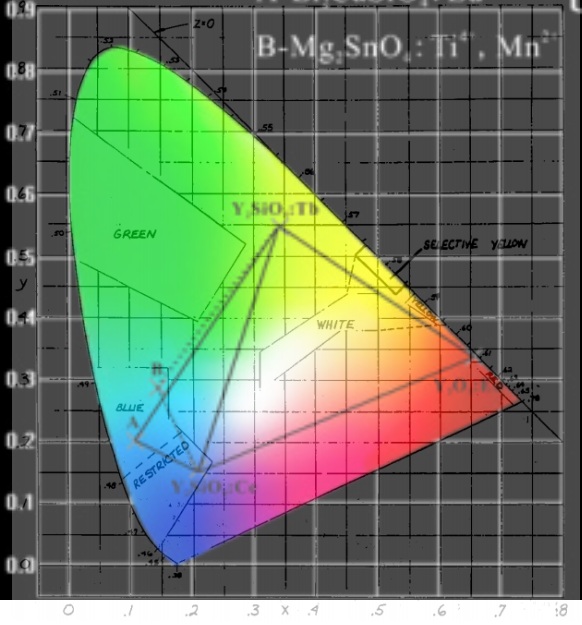Alaric Darconville
Flashlight Enthusiast
This thread split off from Ford Fusion LED headlamp discussion, trivial argument removed to focus on the meat of the matter.
Last edited by a moderator:
 Help Support Candle Power Flashlight Forum
Help Support Candle Power Flashlight Forum

It seems to me that such sensitivity actually lessens the opportunities for teachable moments and understanding among the newcomers.
.33/.33 is considerably whiter than .50/.44. It might be beneficial to talk about the color spectrum that is 'allowable white'. There certainly are headlights that are whiter than others, legally so as in the case of compliant HID vs OEM halogen.
Strident protest does not make it not so.
Tom
I went and checked and both Philips and Osram use the term "whiter light" in their product descriptions
and that is a term that most people understand
CCT may be the easiest, and somewhat more precise, way to convey the color of light. At least within a given context.
I can honestly say that whenever I have used the phrase "whiter light"( and what I have always thought that phrase meant) I have always had reference to the definition that the CIE gives to white light as a "colour stimulus that an observer who is adapted to the viewing environment would judge to be perfectly achromatic and to have a luminance factor of unity." In other words when I used the phrase "whiter light" I was reffering to a light source that was more nearly achromatic than a comparable light source, which is a legitimate usage of the phrase. I have never used it to refer to blue lights, or green lights, and I most definitely agree with you that that is an improper usage of the phrase.All that said, there is a legitimate use of the phrase "whiter light" that is readily understandable to people who don't know (or want to know) anything technical about light: it means light with less of a color cast than some other light. That could be less-orange, less-yellow, less-violet, less-blue, less-red, etc.
I can honestly say that whenever I have used the phrase "whiter light"( and what I have always thought that phrase meant) (...) I was reffering to a light source that was more nearly achromatic than a comparable light source, which is a legitimate usage of the phrase.
I have never used it to refer to blue lights
just sign on with Philips or Osram or any of the other makers as a marketer, and you, too, can earn money for convincing people that bluer lights are "whiter"!
One has to wonder if they really do work in a fog-free office environment...Not interested in going down that rabbit hole, even though it pays good LOL
SPD is a fine tool for comparing and understanding, if you can get the information.
But at the crux of the matter is, if I am interested in buying a headlight or bulb, where would I get that information?
CRI is an interesting number. I think it is a bit less esoteric than SPD. Generally speaking (though not entirely) it will tell me how well the light will accurately render color.
But again, where do I get that information for a given headlamp or bulb? Am I limited to rules of thumb?
Do I need to subscribe to a library of technical journals in the hopes that someone will test the new Sylvania SuperSilverStar Racing +666 and tell me that the CRI is, um, 20?
When I am figuratively standing around the water cooler having a conversation with someone who sure seems to be knowledgeable, I'm going to say "...anything much 'whiter' than conventional halogen bothers me.."
In a paper published by the National Highway Traffic Safety Administration, the legal authority of the United States of America, makes a dozen references to whiter light.
"HIDs are not just more white (having less yellow content and more blue content in the emitted spectrum)
"As introduced, the halogen lamps, generally, were not intended to be more intense than non-halogen headlamps; their only distinguishing characteristic was that they were whiter in color than other headlamps in use"
There is another aspect to this that I think may be being overlooked and it may or may not apply in this case, and that is the meaning of words is not immutable.
if 90% of the people who use the words everyday including the government, major corporations, and a host of other people, are using it to mean "bluer light", and that's all most people understand it to mean, wouldnt it eventually get to the point wherein it would be pointless to insist that the word means something that's almost obsolete now?
In this experiment the headlamps were arrayed directly in front of the subjects at a distance of 40 meters, with the LED lamps in the central positions and the others to the right and left of center. The subjects were to look at a point situated below the lamps.
It would seem that a more realistic experimental set up would be to have the lamps each positioned ~4 meters to the left of the subjects' vehicle center-line, out 40 meters, with the subjects focusing on a spot directly in front of them at a distance of 40 meters. This set-up would more accurately reflect the on-road positioning